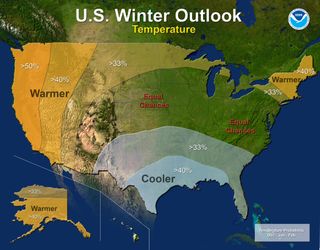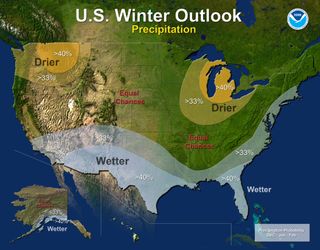Winter Forecast for US Nothing to Shiver About

Don't expect the polar vortex to pummel the eastern United States this winter, government scientists said today (Oct. 16).
Overall, forecasters expect mild winter conditions across much of the United States, scientists with the National Oceanic and Atmospheric Administration (NOAA) said as they issued their annual winter weather outlook.
While there's always a chance that the polar jet stream will again funnel frigid Arctic air south toward the United States, nothing in the new forecast indicates a rerun of the persistent patterns responsible for the "polar vortex." "We do not expect to see a repeat of last winter," said Mike Halpert, acting director of NOAA's Climate Prediction Center.
Developing El Niño conditions in the Pacific Ocean will influence this year's winter weather, with wet conditions forecast from Southern California to South Carolina, and dry conditions expected across the North. Temperatures will be warmer than average in the West and in New England, but colder in the South from Texas east to Florida, according to the forecast. [Winter Wonderland: Images of Stunning Snowy Landscapes]
However, El Niño is still struggling to emerge in the tropical Pacific, so any effects may be mild at best. An El Niño is marked by warmer ocean water in the eastern tropical Pacific and a change in wind and rainfall patterns. While NOAA still expects a full-blown El Niño to develop by Dec. 31 (the odds are currently 67 percent), the outlook now calls for a weak El Niño.
The weak climate pattern makes it harder for forecasters to predict winter temperatures and precipitation. "Weak El Niños are not nearly as reliable as strong events," Halpert told reporters during a telephone conference.
A strong El Niño can create atmospheric wind conditions that block the polar jet stream (called the polar vortex when it dipped south last winter), as during the winter of 1997-1998, Halpert said.
Sign up for the Live Science daily newsletter now
Get the world’s most fascinating discoveries delivered straight to your inbox.

Drought continues
California's historic drought will continue through the winter, forecasters said. The state could see some relief in Southern California, but forecasters said there's a 33 percent chance of below-average snowfall in the Sierra Nevada mountains. The winter snowpack is a critical water source for the entire state.
Nearly 60 percent of California is under exceptional drought — the worst category — and 2013 was the state's driest year on record.
"The forecast is unlikely to refill reservoirs and recharge groundwater in the state," said Kevin Werner, NOAA's western regional climate services director.
The annual winter outlook does not predict when rain or snow may hit or forecast seasonal precipitation totals.
Regional outlooks
- Warmer-than-average temperatures are forecast for Hawaii, the western United States west of the Rocky Mountains, the northern tier from Washington to New York and New England, and all of Alaska.
- Colder-than-average temperatures are expected for the south-central and Gulf Coast states, including Eastern New Mexico, Texas, Louisiana, Alabama and Florida.
- New drought conditions are likely to develop in Northeast Oregon, Eastern Washington and parts of Idaho and Western Montana.
- Above-average precipitation is predicted across the southern United States and along the East Coast north to Maine. Even Southern California will see above-average rainfall, along with the Southwest, the Southern Plains, the Gulf Coast and the Eastern Seaboard.
Email Becky Oskin or follow her @beckyoskin. Follow us @livescience, Facebook & Google+. Original article on Live Science.

Most Popular

